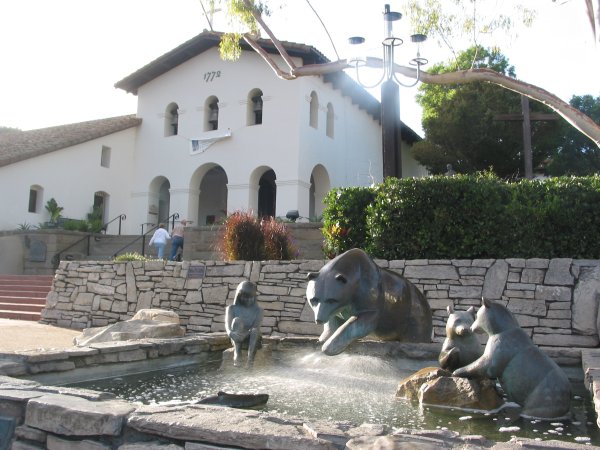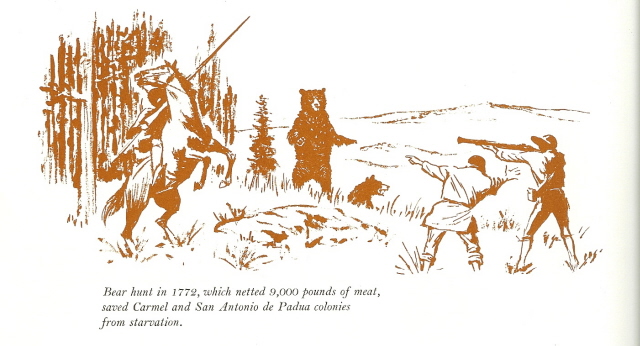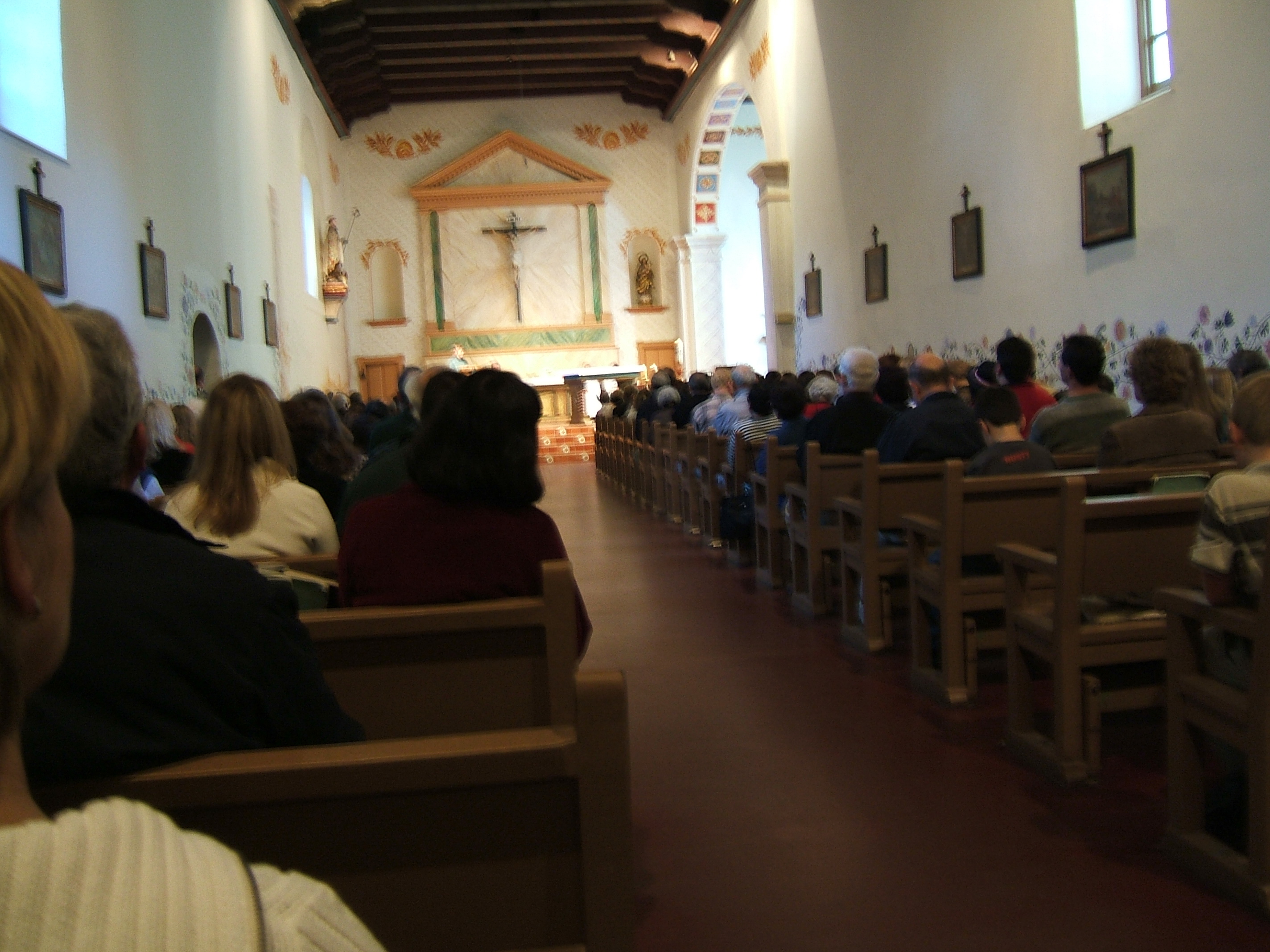Because of the communication problems the Spaniards compensated by extremely elaborate written plans of action. Exploring and colonizing ventures were provided with in-depth volumes of rules, instructions and contingency plans. These plans were so elaborate that they dictated the color of the cloth to be given to the Indians. In theory the Viceroy would not need to consult the King. Merely refer to the voluminous set of rules and instructions.
Colonial settlement was developed
with closely intertwined cooperation between the clergy and the military.
The first stages of the take-over of an alien land were accomplished by use
of the sword, the cross or both. The military invasion set the stage in
Soon after the expulsion from New Spain of the Jesuits in 1769, Jose de Galvez, Visitor-General, turned the Baja California missions over to military administrators under Captain Gaspar de Portola and then to the Franciscans under Father Junipero Serra. Galvez was the most effective visitor-general in the history of New Spain. The vista was a distinctively Spanish Administrative technique for investigations and reorganizations, and a visitador-general was a special deputy of the King, with extraordinary powers overlapping and sometimes transcending those of the Viceroy. [4]
The urgency to now colonize Alta California, some one-hundred sixty-seven years after Sebastian Vizcaino had discovered and mapped the coastline, was prompted by fear that the Russians had eyes set on the territory and may be planning to seize it. Plans were immediately dusted off and twin expeditions by land and sea were to be sent from a base in Baja California to colonize the port of Monterey, with the port of San Diego selected as an intermediate stopping point. Leadership of the project was assigned to Portola who had recently been appointed governor of Baja California. Since there was little to govern in Baja, Portola was delighted to lead the party. Under Portola, Fr. Serra was relieved of his presidency of the Baja missions to take charge of this more important work. The master plan and rules had long been in place but as with most undertakings of this type the leader had authority to make changes according to their views. These appointments and the subsequent actions of these two capable men marked the beginning of the development of California.
San Luis Obispo de Tolosa Founded September 1, 1772:
When Portola headed for Monterey around September 7 - 8, 1769, he and his party traveled through the future San Luis Obispo area on his way to rediscover (remember that initially on his first visit he did not recognize Monterey because of Vizscaino’s exaggerated description of) the Bay of Monterey. The expedition’s secretary, Padre Juan Crespi, O.F.M., listed the name given to this area by the soldiers as llano de los Osos, or the level of the bears (Bear Plain) simply because of the great number of bears sighted and the evidence or their presence. Various translations of the Crespi Diary have called this area La Canada de Los Osos (The Canyon of the Bears) which has been further mistranslated as the Valley of the Bears. At any rate it is known today as Los Osos and it is commonly called the Valley of the Bears. The valley can actually be credited with the salvation of the entire mission expedition because it is unknown what would have happened had the expeditions of the future not remembered this valley for its valuable food source.
In 1770, Fr. Serra founded the
second mission, San Carlos Borremeo, in Monterey which was moved to Carmel
the following year. As supplies dwindled in 1772, at the then four missions,
the people faced starvation. Remembering the Valley of the Bears, a hunting
expedition was sent to bring back food in the summer of 1772. Over 25 mule
loads of dried bear meat and seed was sent north to relieve the missionaries,
soldiers, and neophytes (baptized Natives). The Natives were impressed at
the ease by which the Spaniards could take down the huge grizzles with their
weapons. Some of the meat was traded with the local people in exchange for
edible seed. It was after this that Fr. Serra decided that La Canada de Los
Osos would be an ideal place for the fifth mission. The area had abundant
supplies of food and water, the climate was also very mild, and the local
Chumash were very friendly. With soldiers, muleteers, and pack animals carrying
mission supplies, Fr. Serra set out on a journey to reach the Valley of the
Bears. On September 1, 1772, Fr. Serra celebrated the first Mass with a cross
erected near
Building San Luis Obispo
Father Cavaller was able to enlist
the aid of the local Chumash Natives. Palisades were set up as temporary buildings,
which were made simply from poles and tree boughs. These structures were
quite susceptible to fire and on a November night in 1776 the first of several
fires was spotted by a watchman. The fire spread quickly as the watchman
roused the residents to fight the blaze. Everything was consumed except the
church and granary. [6] 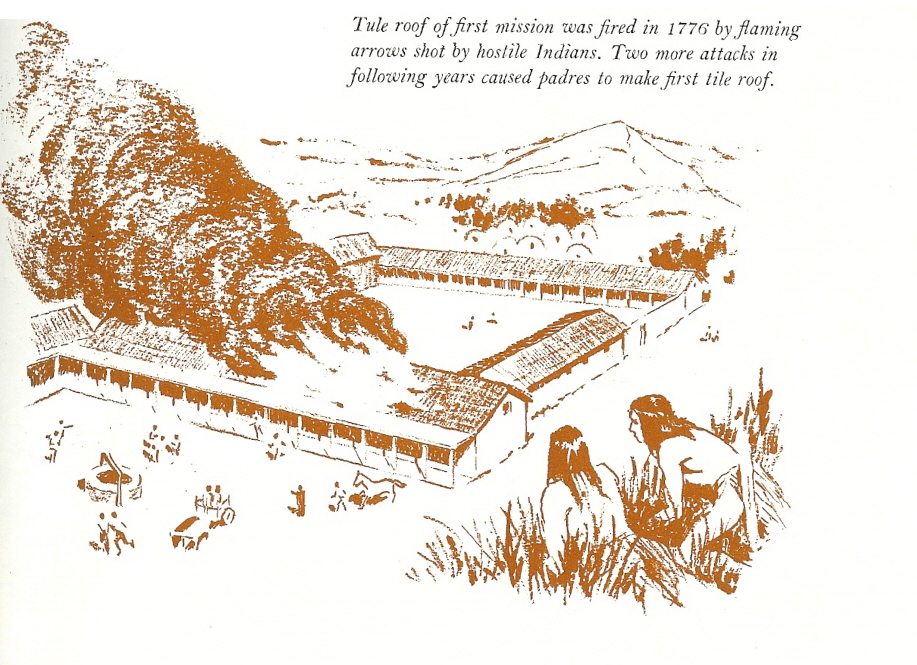 This fire and the ones
that followed prompted the father’s memory of the tile roofs widely used back
in the homeland of
This fire and the ones
that followed prompted the father’s memory of the tile roofs widely used back
in the homeland of
Because of fires in the first
few years, adobe and tile structures would now become the preferred method
of construction. The Church and Priest's residence, the convent wing, were
built by 1794. Many other structures made up the Mission in the early days:
storerooms, residences for single women, soldiers barracks, and mills. The
mission also had land for farming and raising livestock. The whole community
of priests, Natives and soldiers needed to produce goods for their own livelihood.
These pictures show the mission as it was originally constructed. This first
picture is the Southerly side of the Mission San Luis Obispo de Tolosa; this
being the side that is alongside the creek that is just out of view but only
about 150 feet from the mission walls. This is the court yard of the mission
and is a beautiful park setting today with its future secure that it will
never be destroyed or significantly changed 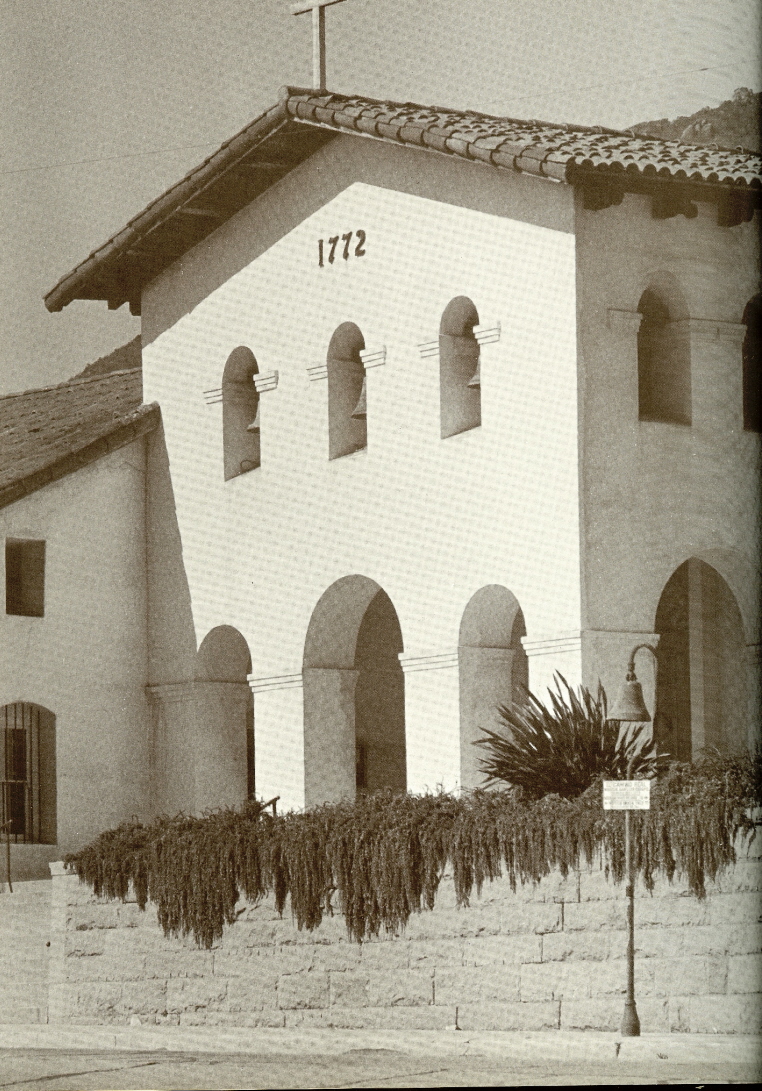 [7]
[7]
Later (last page) there is another view of this same area but as it is today. I think it is important to note the significance of the mission to the development of the area and also the feeling can almost emulate from the people in this picture that this is their place and it is the center of their lives. When one gives serious thought to the overwhelming influence that the missions had and how that exuberated to the people who chose or were drafted (as is the case of the neophyte) to live there; we then must be compelled to give credit and pay homage (with some reservation) to these courageous Franciscans that made this possible.
Next is an old picture of the
church from circa 1880. This was a time when earthquakes had taken their
toll and a remodeling was due or under way. Note the boarded exterior and
the absence of the roof tiles (removed because of weight considerations during
the remedial period) but the presence of the New England steeple. Also note
the wing to the right of the main hall of the church. Actually that wing
has been expanded a bit and now the seating is nearly the same in either wing.
I will show the first remodeling following this picture from around 1930 when
the boards were removed and the adobe restored to [8] the original texture. 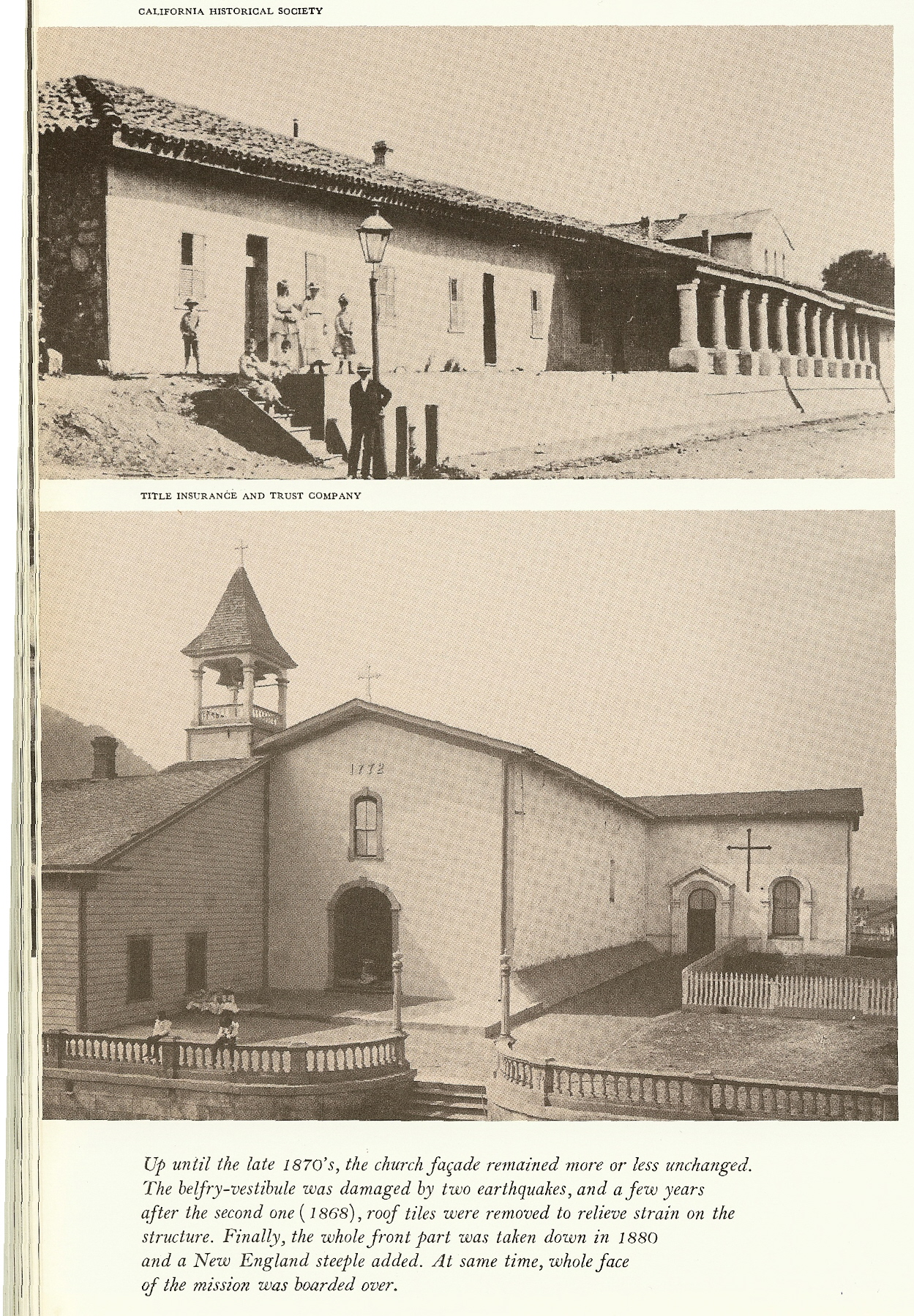
Note the date 1772. The next
picture will be circa 1930. 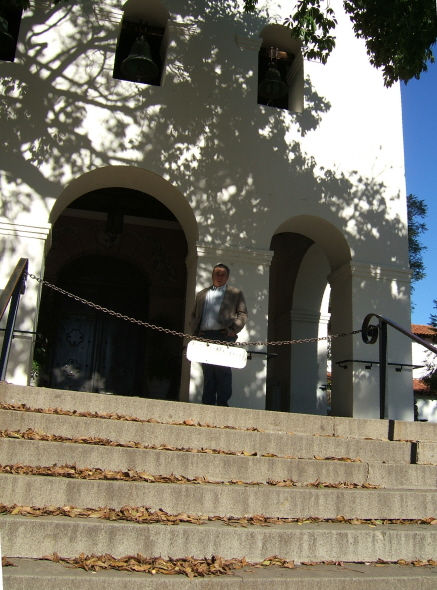 Today the building is exactly as it was here but you will notice a good
bit of tree growth and the leaves and limbs partially obscure the date over
the church entrance. Actually I am uncertain what would be properly described
the entrance here, there is one from the court yard and three more on the
other wing (remember the one on the right? it is back there) but I don’t have
a good shot of it. But you can see it just past the corner, that wing is
about 150 feet of so beyond the corner of the church. We did not get the
date, 1772, visible in this photo. It is almost visible in the photo on page
8 line 19 but obscured by the tree.. I attended mass here today, Sunday January
30, 2005 and there were at least 200 people in attendance. Fortunately there
were three baptisms during this mass, two were about 8 year old twin brothers
and the third was a baby boy about 18 months old. Here am I standing just
outside the entrance following the 9:00 a.m. mass.
Today the building is exactly as it was here but you will notice a good
bit of tree growth and the leaves and limbs partially obscure the date over
the church entrance. Actually I am uncertain what would be properly described
the entrance here, there is one from the court yard and three more on the
other wing (remember the one on the right? it is back there) but I don’t have
a good shot of it. But you can see it just past the corner, that wing is
about 150 feet of so beyond the corner of the church. We did not get the
date, 1772, visible in this photo. It is almost visible in the photo on page
8 line 19 but obscured by the tree.. I attended mass here today, Sunday January
30, 2005 and there were at least 200 people in attendance. Fortunately there
were three baptisms during this mass, two were about 8 year old twin brothers
and the third was a baby boy about 18 months old. Here am I standing just
outside the entrance following the 9:00 a.m. mass.
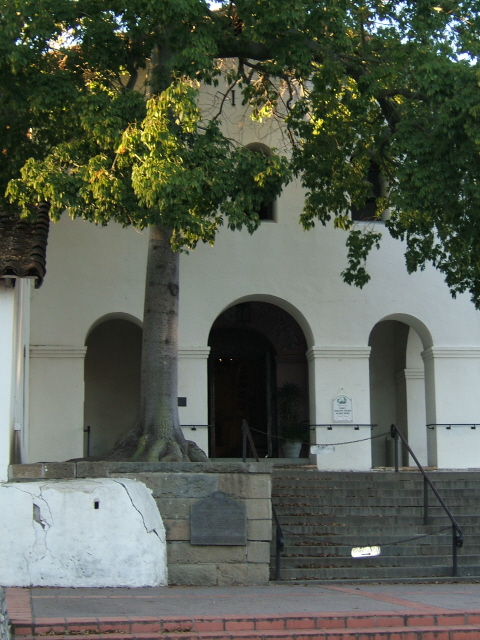
The mission proper covers a full block and has always been the focal point of San Luis Obispo fully functional and very active. I remain profoundly in awe of this extraordinarily beautiful creation.
This is a little better picture just to show the date on the church. Look behind the limbs. You need good eyes.
Notice how the tree has grown
up around the entrance. The next photo, below, is me near the statue of Father
Serra; about 30 – 40 feet to the right of the steps above and right.  Having satisfied the two picture requirement let me at least show a couple
of more shots that depict the great beauty of this mission and the surrounding
town.
Having satisfied the two picture requirement let me at least show a couple
of more shots that depict the great beauty of this mission and the surrounding
town.
These photos of the creek (Fr.
Serra chose the site of the mission because of the creek) that the rest of
the town has built over. That’s right the creek runs under the town streets
and buildings for about 7 or 8 blocks and being a popular field trip for Cal
Poly students. This is looking in an Easterly direction from about 100 feet
in front of the church entrance.  The next photo is of the creek running the other direction, Westerly. The
creek does run year around and is fed by springs from the mountains east of
the city. The city has done a beautiful job of protecting and utilizing the
natural resources and beauty that they have been endowed with. For the most
part the city is good at maintaining the mission atmosphere.
The next photo is of the creek running the other direction, Westerly. The
creek does run year around and is fed by springs from the mountains east of
the city. The city has done a beautiful job of protecting and utilizing the
natural resources and beauty that they have been endowed with. For the most
part the city is good at maintaining the mission atmosphere.

The next photo is inside the church from the entrance that I have shown above (3rd and 4th picture) during mass. Five or six people can sit in each pew and there about 40 rows.
One can get a concept of how large the room is. It is hard to see but the large ceiling beams are about 10 x 24 hewed beams on about 4 foot centers. The pulpit is laid out in a diagonal so that both wings are faced. You can see the beautiful arch on the other wing. By the way, this is the only one of the twenty one missions that had a church layout in this ‘L’ shape with the two wings. I have a lot more pictures, but there is more important information that must take precedence. Anyone who would like pictures can look on my website, http://cortezcate.com in about a week and I will have them posted there. Four pictures back I am standing under a statue of Father Serra. Physically he was a very small man, barely 5’2” tall but, emotionally, professionally, vocationally and as a visionary this man was truly a giant among men. I have developed doubts about the motives and true spirituality of Father Serra as well as the Franciscan order in general. These are personal observations and not supported by documentation at this time.
Commerce; Productivity and Population:
The Spaniards kept meticulous records of mission activities. Each mission was required to submit an annual report summarizing its spiritual and material condition and status to the Father-President. It was truly remarkable of the progress that the missions accomplished. For me it is an eye opener to read other reports of the missions because I feel the history books should give a bit more credit and explanation of the remarkable progress that the missions actually achieved. I was under the impression from out text that they were borderline failures. A good explanation is what I need of why there was so much friction between the political and clergy arms of the new settlements and if that were common or was it isolated to California? I am beginning to believe that it was the leadership of Father Serra that was so far in advance of anyone who had come before him and this likely created a jealousy in the political arm of government causing the politicians to attempt to suppress the mission activity. This is however pure speculation (as well redundant) on my part at this time and while I fully intend to investigate further and attempt to learn what actually happened I do not take a firm stand either way right now.
Spiritual: Population:
The spiritual records as of December 31, 1832 are both impressive and a little bit puzzling. San Luis Obispo reports 2,644 baptisms, 763 marriages, 2,268 deaths and 231 neophytes. These records are cumulative. San Diego reports 6,522 baptisms, 1,794 marriages, 4,322 deaths and 1,455 neophytes. San Luis Rey the 18th mission founded in 1797 reports 5,399 baptisms, 1,335 marriages, 2,718 deaths and a whopping 2,788 neophytes. It is obvious they were doing something right (hopefully) at San Luis Rey. Regrettably I have run short on documentation concerning population. The mission had some information on exhibit but I must have neglected to properly record it and have not been able at this time to recover that information.
Material:
At San Luis Obispo (remember, the totals as to the Spiritual Records are cumulative but the material lists are ‘as of’) as of 1832 there are 2,500 head of cattle, 5,422 head of sheep, 700 horses, 200 mules, for a total of 8,822 and additionally there is 97,405 Fns. Wheat, 31,346 Fns. Other. [9] Compare to San Luis Rey with 27,500 head of cattle, 28,100 head of sheep, 1,300 goats, 300 hogs, 1,950 horses, 180 mules, for a total of 57,330 head of livestock. Additionally they have 26,452 Fns. Wheat and 66,204 Fns. Other. [10]
San Luis Obispo’s rank is rather low in the material aspects with only 5 missions being lower in totals. San Luis Rey on the other hand has twice as much as its nearest competition which is San Gabriel with 26, 342 head and San Jose a close third with 24,180. [11]
I have not been successful, as of this writing, in locating accurate records pertaining to the number of persons actually at the mission at a given time. In the Spiritual lists above I noted the large number of neophytes that San Luis Rey reported but this is a cumulative record I believe. I want to learn what the ongoing totals of population were at given times and will seek that information during this course. If anyone could lead me in a direction that would reveal this information my email is cecate@pacbell.net .
These numbers do not tell the
whole story but gives an idea of how viable the missions were. They had actually
reached their peak around 1832 just two years before secularization in 1834.
One wonders if they were just coming to fruition or if this was just an anomaly
of the history. There seems to be little doubt that the natives were ever
much more than forced laborers. Certainly the missions and the government
failed to grant the natives the education necessary for their blending with
this new society. All that can be learned in the missions, rancheros and
presidios blends perfectly with the study of the history of this great state.
It is sad that such atrocities were committed both before and after this great
state joined the
The Missions of California is a story for all times and has forever left an indelible impression on me. I am inspired to continue to study and learn more of this great institution and this great State.

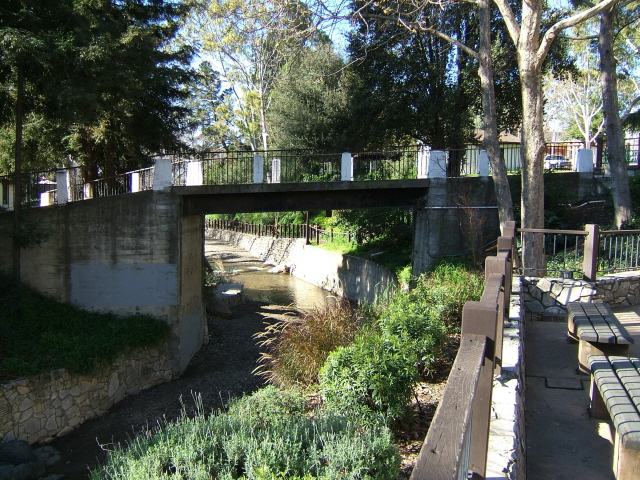
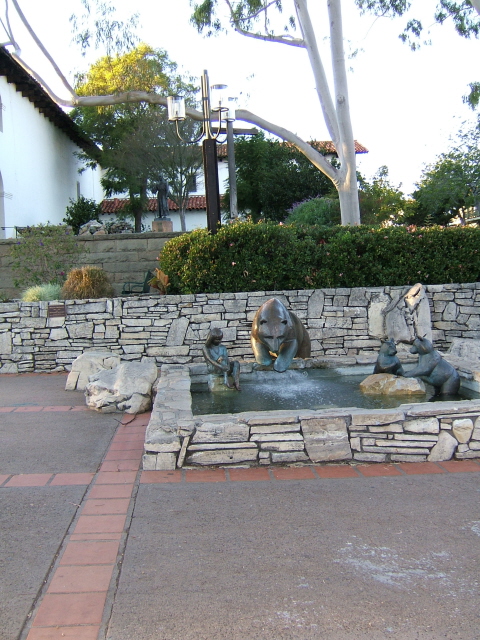
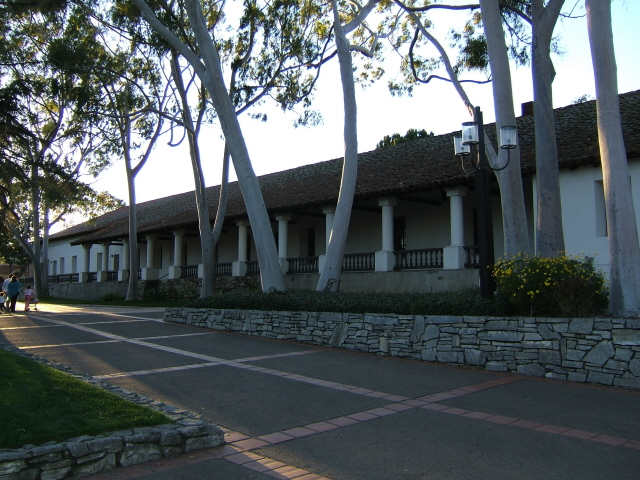
(1) Above the fountain depicts the Los Osos connection; Fr. Serra, cross and church in the background. (2) SW corner (this is same area as the first, page 6, line 10, of the old photos above) today. (3) Me at the plaque near church entrance. (4) Looking west, 100 feet from church entrance.
